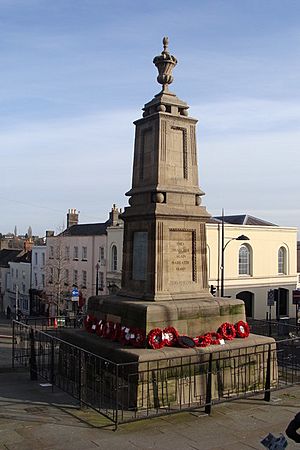Chepstow War Memorial facts for kids
Quick facts for kids Chepstow War Memorial |
|
|---|---|
| Wales | |
 |
|
| For men from the town of Chepstow who died in the First and Second World Wars | |
| Unveiled | 1922 |
| Location | 51°38′31″N 2°40′30″W / 51.642°N 2.6751°W Chepstow, Monmouthshire, Wales
|
| Designed by | Eric Francis |
|
THEY/ SHALL RISE/ AGAIN/ IN GREATER/ GLORY
|
|
|
Listed Building – Grade II
|
|
| Official name | Chepstow War Memorial |
| Designated | 24 March 1975 |
| Reference no. | 2503 |
The Chepstow War Memorial is found in Beaufort Square, Chepstow, Wales. It remembers the brave people from the town who died in the First World War and Second World War. A local architect named Eric Francis designed it.
The memorial has a special Neoclassical look, which is not common for war memorials. Next to it, you can see a German Naval deck gun. This gun was given to the town by King George V. It was a way to honor Able Seaman William Charles Williams. He grew up in Chepstow and was given the Victoria Cross (a very brave award) after he died in the Gallipoli battle.
In 1975, the Chepstow War Memorial was named a Grade II listed structure. This means it is an important historical building that needs to be protected.
Why We Have War Memorials
The First World War caused a huge loss of life. Because of this, many war memorials were built. They were created across the country to remember those who died. In Wales, about 35,000 soldiers lost their lives. Many towns and cities in Wales built memorials in the 1920s. These memorials help us remember the sacrifices made.
What the Memorial Looks Like
The Chepstow memorial was designed by Eric Francis. His father was a lawyer in Chepstow. Eric learned from famous architects like Guy Dawber and Detmar Blow.
The memorial is made of stone. It has two main parts, like a tall column. On top of the column is a stone urn. The whole thing sits on a stone base with two steps. Each part of the column has special sunken panels on all four sides. Above these panels is a decorative edge with stone balls at the corners.
The design is called Neoclassical. This style uses ideas from ancient Greek and Roman buildings. It is quite unusual for war memorials from that time. John Newman, an expert on buildings, said the memorial is the "most important part" of Beaufort Square. He also noted its "eighteenth century style."
On the lower part of the column, one panel has an inscription. It says, "THEY / SHALL RISE / AGAIN / IN GREATER / GLORY". The other three panels have metal plaques. These plaques list the names of the people who died. Two plaques list those from the First World War. One plaque lists those from the Second World War. The northeast side of the base also says, "Their name liveth for evermore".
In the 1980s, railings were added around the memorial. Members of the Army Apprentices College at Beachley Barracks built them.
The German Gun
Next to the stone column, there is a deck gun. This gun came from a German U-boat (a submarine) called SM UB-91. King George V gave this gun to Chepstow. It was a special gift to honor Able Seaman William Charles Williams. He was a very brave person from Chepstow who received the Victoria Cross.

